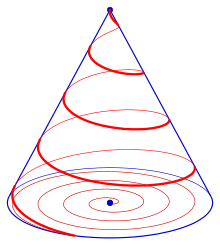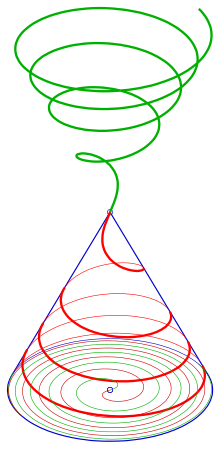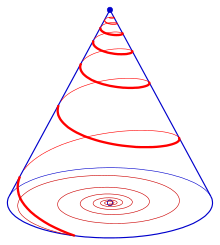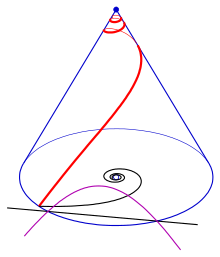



In mathematics, a conical spiral, also known as a conical helix,[1] is a space curve on a right circular cone, whose floor projection is a plane spiral. If the floor projection is a logarithmic spiral, it is called conchospiral (from conch).
Parametric representation
[edit]In the --plane a spiral with parametric representation
a third coordinate can be added such that the space curve lies on the cone with equation :
Such curves are called conical spirals.[2] They were known to Pappos.
Parameter is the slope of the cone's lines with respect to the --plane.
A conical spiral can instead be seen as the orthogonal projection of the floor plan spiral onto the cone.
Examples
[edit]- 1) Starting with an archimedean spiral gives the conical spiral (see diagram)
- In this case the conical spiral can be seen as the intersection curve of the cone with a helicoid.
- 2) The second diagram shows a conical spiral with a Fermat's spiral as floor plan.
- 3) The third example has a logarithmic spiral as floor plan. Its special feature is its constant slope (see below).
- Introducing the abbreviation gives the description: .
- 4) Example 4 is based on a hyperbolic spiral . Such a spiral has an asymptote (black line), which is the floor plan of a hyperbola (purple). The conical spiral approaches the hyperbola for .
Properties
[edit]The following investigation deals with conical spirals of the form and , respectively.
Slope
[edit]
The slope at a point of a conical spiral is the slope of this point's tangent with respect to the --plane. The corresponding angle is its slope angle (see diagram):
A spiral with gives:
For an archimedean spiral is and hence its slope is
- For a logarithmic spiral with the slope is ( ).
Because of this property a conchospiral is called an equiangular conical spiral.
Arclength
[edit]The length of an arc of a conical spiral can be determined by
For an archimedean spiral the integral can be solved with help of a table of integrals, analogously to the planar case:
For a logarithmic spiral the integral can be solved easily:
In other cases elliptical integrals occur.
Development
[edit]
For the development of a conical spiral[3] the distance of a curve point to the cone's apex and the relation between the angle and the corresponding angle of the development have to be determined:
Hence the polar representation of the developed conical spiral is:
In case of the polar representation of the developed curve is
which describes a spiral of the same type.
- If the floor plan of a conical spiral is an archimedean spiral than its development is an archimedean spiral.
- In case of a hyperbolic spiral () the development is congruent to the floor plan spiral.
In case of a logarithmic spiral the development is a logarithmic spiral:
Tangent trace
[edit]
The collection of intersection points of the tangents of a conical spiral with the --plane (plane through the cone's apex) is called its tangent trace.
For the conical spiral
the tangent vector is
and the tangent:
The intersection point with the --plane has parameter and the intersection point is
gives and the tangent trace is a spiral. In the case (hyperbolic spiral) the tangent trace degenerates to a circle with radius (see diagram). For one has and the tangent trace is a logarithmic spiral, which is congruent to the floor plan, because of the self-similarity of a logarithmic spiral.

References
[edit]- ^ "Conical helix". MATHCURVE.COM. Retrieved 2022-03-03.
- ^ Siegmund Günther, Anton Edler von Braunmühl, Heinrich Wieleitner: Geschichte der mathematik. G. J. Göschen, 1921, p. 92.
- ^ Theodor Schmid: Darstellende Geometrie. Band 2, Vereinigung wissenschaftlichen Verleger, 1921, p. 229.
External links
[edit]- Jamnitzer-Galerie: 3D-Spiralen. Archived 2021-07-02 at the Wayback Machine.
- Weisstein, Eric W. "Conical Spiral". MathWorld.
























![{\displaystyle L={\frac {a}{2}}\left[\varphi {\sqrt {(1+m^{2})+\varphi ^{2}}}+(1+m^{2})\ln \left(\varphi +{\sqrt {(1+m^{2})+\varphi ^{2}}}\right)\right]_{\varphi _{1}}^{\varphi _{2}}\ .}](https://wikimedia.org/api/rest_v1/media/math/render/svg/9b7d08c7b1cbf61235824dc591b7898109e0d0b2)























Well, that’s interesting to know that Psilotum nudum are known as whisk ferns. Psilotum nudum is the commoner species of the two. While the P. flaccidum is a rare species and is found in the tropical islands. Both the species are usually epiphytic in habit and grow upon tree ferns. These species may also be terrestrial and grow in humus or in the crevices of the rocks.
View the detailed Guide of Psilotum nudum: Detailed Study Of Psilotum Nudum (Whisk Fern), Classification, Anatomy, Reproduction